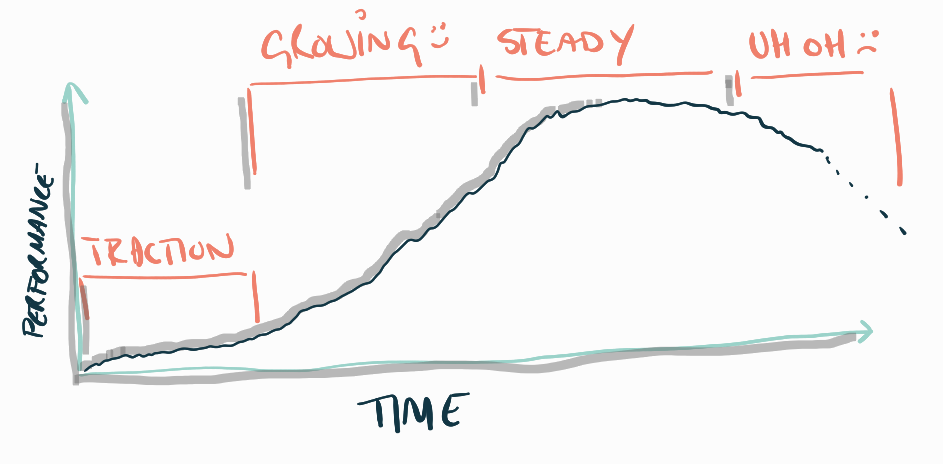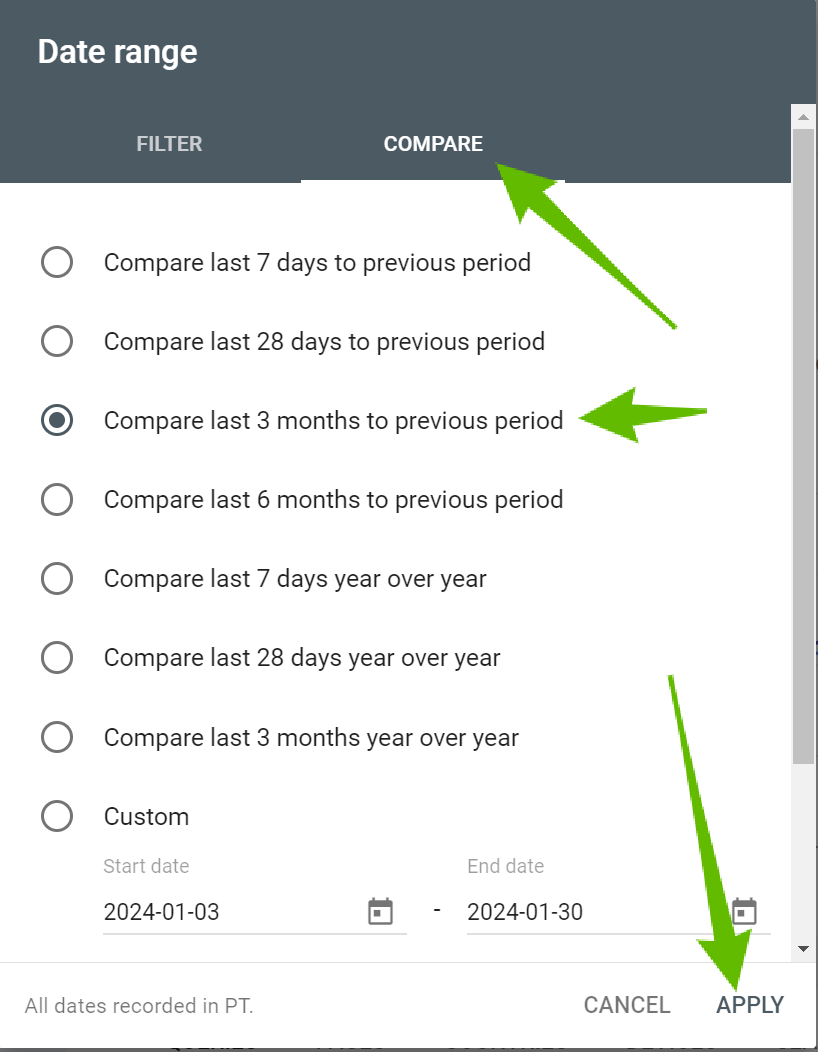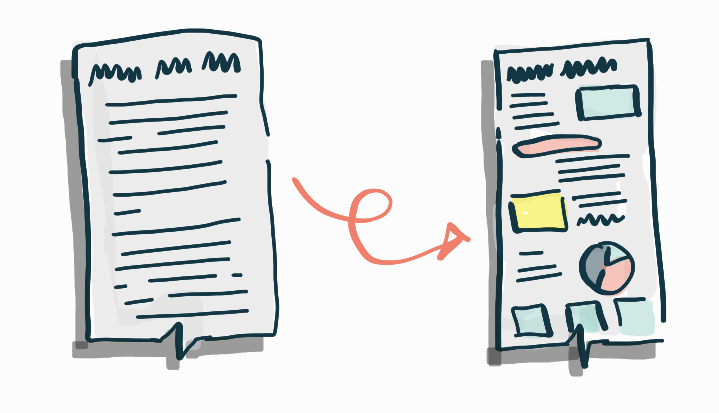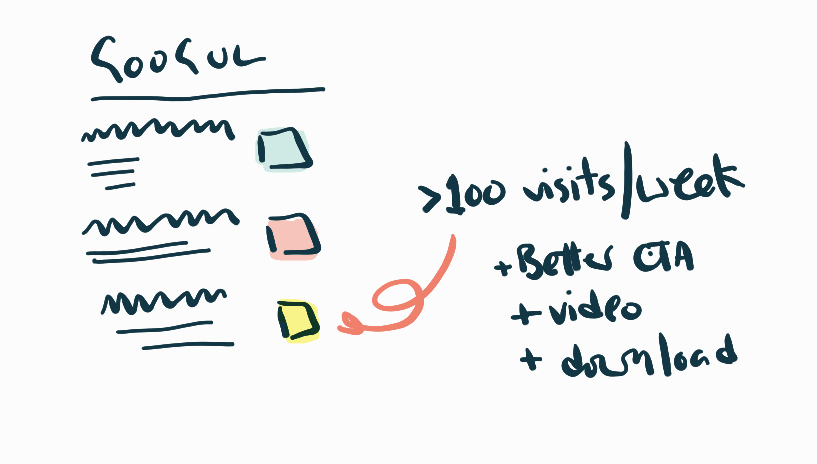You’ve sweated countless hours into your blog posts. Passionately crafting well-structured, insightful pieces, each word meticulously chosen to captivate your audience.
Yet, even after all that work, you watch them slowly sink into the forgotten depths of Google’s algorithmic abyss. Page 2…
That’s like baking a cake, only to drop it face-first on the doorstep, isn’t it? Happy birthday to the ground.
Ten years and thousands of forgotten posts later, I’ve seen one truth roar louder than ever – SEO is not set-and-forget. You have to look after what you made. Water your plants.
Whilst it’s not the sexy, “new keywords, new content” that gets the budget. It’s the foundation of looking after what you’ve already made. It’s the groundwork you need for everything else to succeed.
We’re gonna get straight into it because that’s why you’re here. My step by step guide on how to update all your old content with a content refresh.
Want all the deets but prefer listening to reading?
No problem, you can listen to the discussion of this blog on our Podcast, Content Conversations. Or, grab a listen right here:
Step-by-Step Guide to Updating Old Content
Key takeaways
- Identify content that needs updating.
- Analyze old content’s performance.
- Research for updated keywords and SEO trends.
- Revise and update the content.
- Republish and promote updated content.
Step 1: Identifying Content That Needs Updating
Before fixing old content, you need first to identify what requires an update.
You’re looking for content that was popular once but has seen a decline in traffic. These pages can be mined for valuable SEO gold. Crawling tools, your own analytics and manual evaluation might be necessary to optimize the selection process.
The traffic graph for decaying content looking something like this –

Using Analytics for Identification
Analytics platforms can be vital for pinpointing pages that were once high-performing but have lost their shine over time. Looking at your historical data will highlight pages that used to drive substantial traffic but have since dwindled.
We’re looking for the “uh-oh” pages.
My go to here is Google Search Console. You’re going to want to perform a content decay check. The quickest way to do this is to grab page performance from the last 3 and 6 months time.
It looks something like this.
Head into Google Search Console
Click on Search Results, then over onto Date

Now click on compare > compare last 3 months > apply

Scroll down a touch and grab your pages, and order by *clicks difference*
We want to see the pages that have dropped off over the last 3 months.

It should look something like this. Now I have a list of pages I can see what’s going on. Where they might have slipped and to put them through the next few steps to improve.
Looks like we have our work cut out over here.
-23,176 clicks? 🤢

If you don’t see much, re-run the comparison against 6 months.
I like to pull this list into a spreadsheet and date them from when the data was pulled, and then when the changes were made. I’ll put a task in my to-do to check these pages in 2-3 after the changes are done to see what improvements we got.
Step 2: Analyzing the Performance of the Old Content
After recognizing the content that needs updating, it’s time to analyze its performance critically. This probing analysis determines the strong and weak areas of the content. It may include assessment of metrics like bounce rates, time spent on the page, or visitor engagement.
My go to checks for content look like this
When a page is losing traffic ➡️ review manually
- If content is out of date, doesn’t match search intent BUT is indexing for the keywords it was written for ➡️ Rewrite
- If it requires more editing than it’s worth for it to rank ➡️ Rewrite
- If content is thin (under 1000 words) AND does NOT cover topic thoroughly ➡️ Rewrite
- If content has over 1,000 words but is missing keywords + context ➡️ Refresh
- If content is missing on page elements (h2s, media etc) but is otherwise good ➡️ Refresh or Update Media
- If content appears to be good, but page is lacking links (< 8 internal links) ➡️ Target w/ Internal Links first
A refresh means update. It means check the headings for relevant keywords. It means adding more images. It means add quotes, embeds from your podcast/YouTube/social. It means making it feel new.
Rewrite means start again. It means get rid of what is there and start from scratch.
For the time being we’re just labelling things with what needs to be done. Not actually doing it. That is step 4.
Step 3: Researching Updated Keywords and search intent
Next, conduct in-depth keyword research and stay in tune with the latest SEO trends. Keywords can and will fluctuate with changes in market focus, or algorithm updates, and your content should accurately reflect this. As markets self educate, the intent behind keywords change.
What was once a ToFu “what is this…” type keyword could now be a product page as the market knows what it is and is just looking for a solution.
The Importance of aligning to search intent
Updating old content to suit new search intent is a failsafe way to re-rank it. Most of the time you don’t have bad content. Unless it’s <1,000 words. Most of the time you’re just not answering the question people have when they’re making that search.
Give each blog a job
What I mean by a job is a keyword for it to rank for. If your content isn’t ranking for anything, or it’s ranking for things that make no sense then you’re going to want to re-align that article. If you don’t have a reason for it to rank, then you better have another way to get eyes on that content. Give it a job, give it a keyword. Then optimize toward that keyword.
Step 4: Revising and Updating the Content
It’s time to shine up those old posts. This may involve updating facts, improving readability, restructuring of the content, enhancing graphics, adding meta tags, or refreshing outbound and internal links.
Always remember – the goal is to improve user experience and make the content more valuable to readers and search engines alike.

A first pass on all content should be spacing. Remove any sections where you have a top to bottom “wall-of-text”.
Make it easier to read for everyone.
Break that text up into smaller paragraphs.
Add more headers to it.
And for large sections, introduce it with a quick bullet summary. (This helps with skimmability)
The four states to update
Another way to look at what content to update is to check how well it’s ranking and how much traffic it’s getting for it’s target keyword.
Ranking well, getting traffic
These are the articles doing well. They rank for their target keywords and get a lot of eyes on them. For me once an article is getting 100+ visitors a week we want to change our goal from SEO increases to conversion increases.

Things like
- Adding CTA’s/signups/relevant next blogs
- Adding videos
- Creation of content specific downloadables
- Potentially adding more context to the article
What you do not want to do is fundamentally change the concept of the content. Don’t switch huge things around. Don’t “fuck with it”. Just add to it.
Google has placed it high for a reason, and that reason is usually the “feel of the whole blog”. Don’t change that. Changing that more often than not results in you losing positions.
Pos 8-25
Content ranking here is on the right track, but needs a little something extra.
Often you’re missing search intent. Why are people searching what they’re searching for? Are you actually answering that question or just addressing it?
You’ll want to add things like
- Core keyword in the H1/H2’s. You’re likely missing it
- Shorter paragraphs and bullet lists to making skimming easier (improve readability)
- More internal links.
Pos 25+
Content ranking here is usually in one of two spaces. It’s either just been published in which case; do nothing. It’s not old enough for you to be making content decisions on it yet. OR it’s been live for a while and it’s stuck.
The most common reason why it’s stuck is it doesn’t match search at all. It’s not even close. Go and take a deeper look at the pages ranking for the keyword you’re going for. See what patterns they all follow.
How are they talking about the keyword/keyphrase you’re trying to rank for? More than likely you’re missing something obvious that 5+ pages on the SERPs are doing well.
The second most common reason why you’re not ranking? Likely word count. Check the average word count and make sure you’re matching that average.
Pos 50+
Rewrite. If you’ve been holding this position for your core keyword for 6-12 months. You likely need to rewrite the whole thing.
This is a nobody page. As in, nobody is ever going to find
Step 5: Republishing and Promoting the Updated Content
Finally, republish your newly enhanced content and begin promoting it. Content updating isn’t just rewriting, but it’s also rebranding – creating a new, more effective identity for your content that better resonates with your target audience. It’s engine optimization in its truest form.
With these steps completed, you’re prepared to uncover the SEO potential of your old content. The journey doesn’t stop at updating. Now, it’s time to let your polished content shine in all its glory.
How does social and email play a role in content refreshes?
Updating content usually means adding new stats and insights to the content to bring it up to speed. Don’t let that research go to waste, be sure to build a few posts around the new research, comparisons, and insights to post on social.
And email?
Your email list is likely only aware of the few blog posts they themselves read at first. You have two tactics here to introduce your most loyal followers, your email list, to the freshened up posts
- Turn the new posts into email drips, onboarding content and mini courses for your list.
- Re-intro the post back in on the next newsletter.
The second one is the least amount of work, an
And links you ask?
One of the best things you can do is go and get some more links for your site. Usually getting backlinks for a site is a long and painful task. This might be why they’re so good at getting your content to rank. But there are easier ways to get links than you might think.
The tried and tested – “Talk to your people” is a great place to start. If you’ve been using your social to get insights for the content refresh then getting links from those experts is a great place to start.
Some of my new favourite places are SaaS link building community such as Linktopia, or using a site like Featured.com to get yourself on some of the best websites out there.
The Power of Content Refresh Strategy
Key takeaways
- Grasp what content refresh means.
- Learn how updating old content can boost your SEO rankings.
- Glean inspiration from successful content refresh strategies.
Understanding the Concept of Content Refresh
A content refresh isn’t about rewriting every article in your brand’s archives. It’s a regular check you should be doing to keep what you’ve built, standing.
Most of it is a data play if I’m honest. It’s having a way to check what you have, criticise it’s performance and then make the relevant changes for it to continue being an asset.
At it’s core, content refreshing is an investment. You’re updating it because your content is an asset. It’s something owned by you and your business and it should perform as such.
Your main goal is to match you existing content to current industry trends, Google’s ever-evolving algorithms, and your audience’s changing demands. In short, you’re making good content even better to yield greater results.
Why Refreshing Old Content is a Powerful SEO Strategy
When done right, refreshing content can be far more effective than producing entirely new content. It’s a proven, powerful SEO strategy for various reasons:
- Resource Efficiency: It leverages your existing pool of content, saving time and effort compared to creating new content.
- Improved Rankings: Updated content is often rewarded by search engines, leading to better visibility and higher rankings. Fresh information is valuable to both users and search engines, ensuring your content doesn’t stagnate.
- Boosted Engagement: Updated content can drive more user engagement, as it provides new, valuable insights to the audience.
The key lies in strategically choosing which pieces to refresh based on their performance, relevance, and potential for improvement.
The impact of this is huge when done properly.
The graph below is from a site where we took the 100 or so blogs that hadn’t been doing well. We followed the strategy above and within weeks we saw a huge increase in impressions, ranking and clicks.
All from pages that previously weren’t getting anywhere near the clicks we knew they should have been getting.

The SEO Benefits of Updating Old Content: What You Need to Know
Key takeaways
- Boosting search engine rankings.
- Driving increased organic traffic.
- Heightening user engagement and conversion rates.
How updating old content improves search engine rankings
Every business I’ve ever worked with has initially underestimated the positive impact refreshing dated content has on their search engine rankings.
The reality is, search engines, like Google, value up-to-date content, treating it as a marker of relevance. When you tend to old content, updating it with modern insights or current data, Google’s algorithms take notice, giving you a potential boost in rankings.
To put things into perspective, suppose a blog post written in 2012 about SEO strategies has not been touched since. Chances are, the tactics discussed are outdated and irrelevant, potentially even dangerous.
So, if you were to update this post – providing modern insights into SEO strategies – Google would recognise this fresh content and potentially reward you with better search rankings.
Just be sure that when you’re updating an old blog, you actually update it. I’ve seen all too many times where a company has only changed the date on the blog title and the blog remains the same. Do this en masse and you will get slapped by the big G.
Google has been taking an offensive approach to sites doing this. Especially those doing it every month….
Maximizing the Impact of Your Updated Content
Key takeaways
- Ignite the full potential of SEO gold hidden in updated content
- Foster higher audience engagement with innovative promotional strategies
- Master the art of scrutinizing the performance of your optimized content
How often should you run this play?
Depending on how much content you have, you’ll want to run this play at least every 3 months. Once a quarter.
If you have lots and lots of content, over 200 blogs, I’d run this instead of adding more content to the site. Make sure all your pages are pulling their weight. It’s a huge asset you have that’s not performing if you just leave it be and do nothing with it.
d one of the best. I find most people have forgotten to promote their own stuff to their list.
Monitoring the Performance of Updated Content
Auditing the performance of your updated content is rarely a one-time provision, it’s a cycle of continuous review and refinement. GOOGLE ANALYTICS can be an invaluable ally here, offering insights into visitor behavior, engagement rate, bounce rate and more.
Observing these metrics helps you mystify which part of your content is performing well and which requires further tweaking. This proactive approach empowers you to stay ahead of the curve, envisioning a roadmap for future content revisions.
Common Mistakes to Avoid When Updating Old Content
- Not Updating Meta Tags and Descriptions
- Ignoring Broken Links
- Overlooking Fresh, Relevant Images
Updating old content isn’t simply about changing a couple words here and there. There are common mistakes that, when dodged, can maximise content’s potential to rake in SEO gold.
Not Updating Meta Tags and Descriptions
All too often, those revamping old content neglect to update their meta tags and descriptions. Whilst these elements may seem small in the grand scheme of content updating, they are critically important to your website’s SEO performance.
In the digital playground, meta tags and descriptions are your first opportunity to grab the attention of search engines and users alike.
If you have a <3% Click through rate from the search results page, then you should be looking at titles and meta-descriptions to increase clicks.
Writing accurate, catchy descriptions with relevant keywords make your content more appealing to your reader and enhance click-through rates. Consistently updating these tags upon revising old content ensures better alignment with the updated subject matter.
Ignoring Broken Links and Outdated References
Another common oversight is ignoring broken links and outdated references. Both are detrimental to your SEO scorecard and user experience. Search engines, like Google, heavily consider the quality and relevance of your links when determining your page’s SEO rank.
Outdated references can also dampen your website’s credibility. No one wants to read a piece of content that cites a source from a decade ago, right? Regularly checking and updating these links while refreshing your content builds a trustworthy image in the market. And search engines love trustworthy websites. So, keeping the broken links and outdated references at bay is a good strategy.
Overlooking the Importance of Fresh and Relevant Images
Finally, believe it not, many content refreshers give a blind eye to imaging. Just like users, Google appreciates a good image too. Not just for its aesthetic appeal but also for its relevance and freshness. Updated images have a significant impact on SEO and can improve engagement and shareability of your content.
Use images to your advantage – ensure they are crisp, relevant and tagged. ‘Relevant’, because an irrelevant picture does nothing but confuse your readers, and ‘tagged’, because search engines can’t ‘see’ an image. They depend on the text around them to understand and rank them.
Unearthing Your SEO Treasure Trove
Revamping old content isn’t just a nifty trick to keep your website fresh– it’s an SEO goldmine. It elevates your ranking, drives organic traffic, and boosts your digital presence. Every blog post, article, or update is another nugget of golden opportunity.
It’s time for action. Roll up your sleeves, dig through your existing content, and begin transforming it into a glistening, search-engine-friendly powerhouse. Don’t let that potential sit gathering digital dust – bring it back to life, burnished and updated, forefront to command attention and impress Google’s algorithms.
But tell us, how often do you plan to review your older posts? And which SEO techniques will you incorporate to refresh them?
Remember: There’s always more gold to be found - it’s waiting in every sentence, paragraph, and post you write. Keep digging and start excavating your SEO wealth today!
The little bits you need to know
How Often Should I Update Old Content?
With content management and SEO, timing is everything. The frequency of updating old content is a balance between your business’s capabilities and the pace at which your industry evolves. A rule of thumb is reassessing and revising your content every quarter. This ensures factual accuracy, relevance, and fresh perspectives, effectively keeping your audience engaged and Google algorithms captivated. It’s worth noting that the more often you update, the better your content will perform over time.
What Types of Content Should Be Updated?
Evergreen content forms the backbone of your SEO strategy; these pieces are timeless and provide consistent value. However, the ‘timeless’ label doesn’t excuse them from comprehensive updates. Whether it’s a how-to article, a listicle, or an industry analysis, check if the content is still relevant, accurate, and fulfilling its intended purpose.
The second type on your updating radar should be high-performing pieces. These are the golden nuggets that attract a significant chunk of your organic traffic. Regular updates ensure they maintain their stellar performance.
What is a content refresh and why is it important?
A content refresh involves updating and optimizing your existing blog posts and articles to improve their performance and relevance. It’s not about rewriting everything, but rather making strategic updates to ensure your content stays accurate, engaging, and aligned with current SEO best practices. This helps boost your search engine rankings, attract more organic traffic, and keep your audience engaged.
What are the long-term benefits of implementing a content refresh strategy?
- Sustainable SEO growth: Regularly refreshing your content ensures it remains visible and relevant to search engines, contributing to long-term organic traffic growth.
- Enhanced brand authority: Providing accurate, up-to-date, and valuable information establishes your brand as a trustworthy source within your industry.
- Improved user experience: By offering a positive and engaging experience, you encourage visitors to return to your site for more information and potentially convert into customers.
Glossary of Key Terms:
- Content Refresh: The process of updating and optimizing existing content to improve its relevance, accuracy, SEO performance, and user experience.
- SEO (Search Engine Optimization): The practice of optimizing websites and content to rank higher in search engine results pages (SERPs) and drive organic traffic.
- Keywords: Words or phrases users type into search engines to find information. Using relevant keywords in content helps search engines understand and rank your content.
- Search Intent: The underlying goal or purpose behind a user’s search query.
- Google Search Console: A free tool provided by Google that helps website owners monitor and troubleshoot their website’s performance in Google search results.
- Meta Tags & Descriptions: HTML elements that provide concise summaries of a webpage’s content to search engines and users.
- Click-Through Rate (CTR): The percentage of users who click on a specific link (e.g., in search results) out of the total number of users who saw it.
- Organic Traffic: Traffic that comes to a website from unpaid search engine results, as opposed to paid advertising.
- Evergreen Content: Content that remains relevant and valuable over a long period, requiring minimal updates.
- User Experience (UX): The overall experience a user has while interacting with a website, product, or service.


